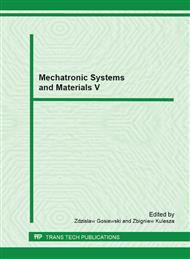[1]
J. Drewniak, S. Zawislak, Synthesis of planetary gears by means of artificial intelligence approach especially graph-theoretical modeling, Solid State Phenomena 168 (2010) 243-248.
DOI: 10.4028/www.scientific.net/ssp.164.243
Google Scholar
[2]
J. Drewniak, S. Zawislak, Linear-graph and contour-graph-based models of planetary gears, Journal of Theoretical and Applied Mechanics 48-2 (2010) 416-433.
Google Scholar
[3]
L.W. Tsai, E. B. Magrab and S.N. Mogalapalli, A CAD system for optimization of gear ratios for automotive automatic transmissions, University of Maryland (1992).
DOI: 10.4271/930675
Google Scholar
[4]
S. Zawislak, The Graph-based Methodology as an Artificial Intelligence Aid for Mechanical Engineering Design, University Press, University of Bielsko-Biała (2010) 284p.
Google Scholar
[5]
J.R. Goma Ayats et al., Hypergraphs for the analysis of complex mechanisms comprising planetary gear trains and other variable or fixed transmissions, Mechanism and Machine Theory 51 (2012) 217-229.
DOI: 10.1016/j.mechmachtheory.2011.07.011
Google Scholar
[6]
A. Srirah, G. Teducondalu and A. Jagadeesh, Mechanical efficiency of planetary gear trains: an estimate, Mechanical Engineering Research 1-1 (2011) 97-102.
DOI: 10.5539/mer.v1n1p97
Google Scholar
[7]
J.F. Sun et al., The automation of kinematics design of planetary gear trains, Advanced Materials Research 338 (2011) 539-542.
DOI: 10.4028/www.scientific.net/amr.338.539
Google Scholar
[8]
I. Rajasni, A. Gupta and Y. Rao, Structural aspect of symmetry and its effect on generation of planetary gear trains, Applied Mechanics and Materials 110-116 (2012) 2619-2622.
DOI: 10.4028/www.scientific.net/amm.110-116.2619
Google Scholar
[9]
C.H. Hsu, J.J. Hsu, Epicyclic gear trains for automotive automatic transmissions, Proceedings of the Inst. of Mechanical Engineers, Part D: Journal of Automobile Engineering 214-5(2000) 323-532.
DOI: 10.1243/0954407001527817
Google Scholar
[10]
J. Drewniak, S. Zawislak, An analysis of multi-speed epicyclic gears by means of graph-theoretical methods, 2012, accepted for printing, Int. J. of Applied Mechanics and Engineering.
Google Scholar


